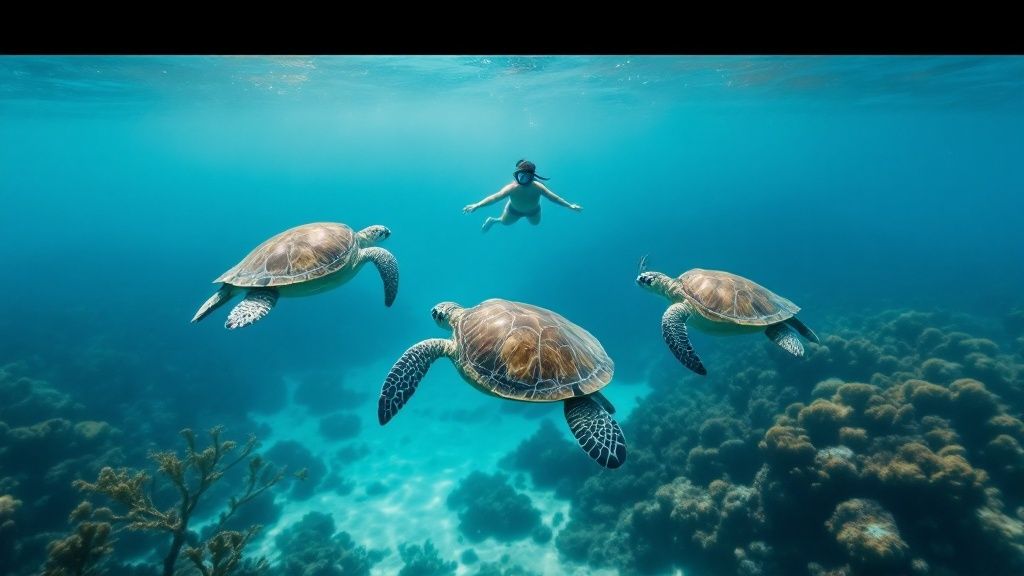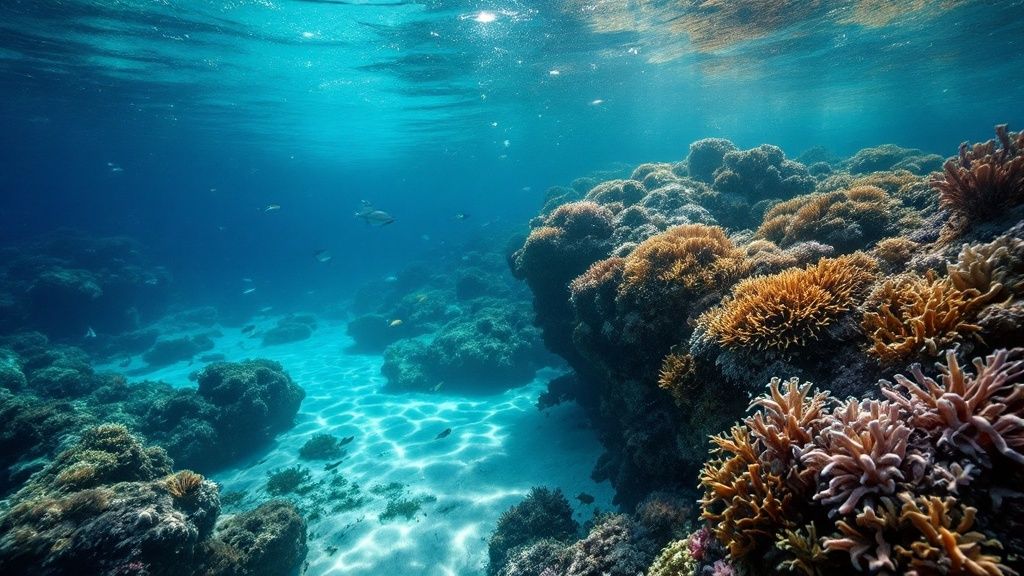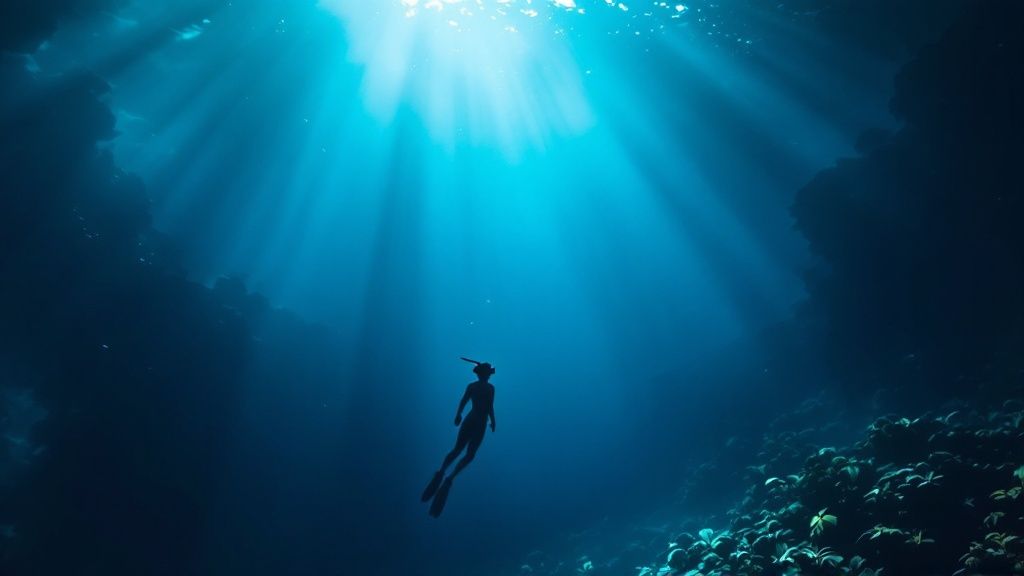Kealakekua Bay Snorkeling: Hidden Hawaiian Reefs
- Kona Snorkel Trips
- Mar 24
- 11 min read
Why Kealakekua Bay Is Hawaii's Snorkeling Crown Jewel
Kealakekua Bay isn't just another place to snorkel; it's an unforgettable experience. The bay's naturally sheltered location creates remarkably calm waters, perfect for snorkelers of all levels, from beginners to seasoned pros. This geological advantage also creates a unique and thriving marine environment. But what truly sets Kealakekua Bay apart is the 100-foot visibility. This incredible clarity transforms your snorkeling adventure, allowing you to fully appreciate the vibrant coral reefs and the diverse marine life within. You're not just observing; you're immersed in their world.

What Makes This Bay So Special?
Kealakekua Bay attracts snorkelers from across the globe for good reason. Its protected marine sanctuary status fosters a thriving ecosystem. This designation helps maintain the delicate balance of the reef and ensures an abundance of marine life. The bay's unique location also minimizes runoff and sediment, contributing to the exceptional water clarity.
This combination of factors creates an underwater paradise consistently praised by marine biologists and experienced travelers. Located on the Big Island of Hawaii, Kealakekua Bay welcomes over 190,000 visitors annually. This popularity reinforces its reputation as a must-see destination. You can learn more about Kealakekua Bay's statistics here: Kealakekua Bay Final Report.
More Than Just Pretty Fish
The biodiversity of Kealakekua Bay extends far beyond simply "colorful fish." You'll encounter a stunning array of species, from vibrant reef fish and graceful sea turtles to playful dolphins. The bay's varied habitats, including shallow coral gardens and deeper drop-offs, support this diverse marine life.
Every snorkeling trip promises exciting discoveries. Sheltered coves provide refuge for young fish, while open waters attract larger pelagic species. This variety is what makes Kealakekua Bay a truly unforgettable snorkeling destination. Whether you're a seasoned snorkeler or just starting out, this bay offers a remarkable chance to connect with the wonders of the ocean. The unique combination of clear waters, abundant marine life, and calm conditions solidifies Kealakekua Bay's status as Hawaii's snorkeling crown jewel.
Unforgettable Marine Encounters: What You'll Actually See

Kealakekua Bay isn't just a place to see "colorful fish." It's a vibrant ecosystem teeming with diverse marine life. This section explores what makes Kealakekua Bay's underwater world so captivating, highlighting the bay's common inhabitants and the best ways to encounter them.
Reef Fish: A Kaleidoscope of Color
The coral reefs of Kealakekua Bay are home to a dazzling array of reef fish. These fish come in every color imaginable, from bright yellows and oranges to deep blues and purples.
Some of the most frequently sighted species include:
Butterflyfish: Known for their intricate patterns and graceful movements.
Parrotfish: Easily identified by their beak-like mouths, which they use for scraping algae off coral.
Surgeonfish: Often seen in large schools, these fish play a vital role in maintaining the reef's health.
Triggerfish: These curious fish can be quite bold, often approaching snorkelers with interest.
You'll also encounter angelfish, wrasses, and many other species, each contributing to the reef's vibrant tapestry.
Dolphins and Turtles: The Bay's Gentle Giants
Kealakekua Bay is a known haven for spinner dolphins. These playful creatures often gather in Zone B of the bay, their primary resting area. Dolphins were sighted on approximately 45.9% of monitoring days between March 2006 and July 2008.
It's crucial to maintain a respectful distance and adhere to ethical viewing practices while enjoying the presence of these animals. Careful observation minimizes disturbance and ensures the bay remains a premier spot for observing these magnificent creatures. Learn more about dolphin sightings and their behavior here: Kealakekua Bay Dolphin Research. For tips on enhancing your snorkeling experience, check out this resource: How to master your snorkeling experience.
Sea turtles, particularly green sea turtles and hawksbill turtles, also frequent the bay. They can often be spotted grazing on algae in the shallows or gracefully gliding through deeper waters.
Time of Day and Seasonal Variations
The time of day and season can significantly impact your snorkeling experience. Early morning is generally the best time to see spinner dolphins as they return from their nighttime hunts. Water visibility is typically best during calmer periods with minimal wind and waves.
Different species may be more active during certain seasons. For instance, humpback whales migrate to Hawaiian waters during the winter months, providing a unique opportunity for whale watching tours.
The following table provides a glimpse into the diverse marine life you can encounter in Kealakekua Bay:
Common Marine Life in Kealakekua Bay: A comprehensive list of marine species typically encountered while snorkeling at Kealakekua Bay, including frequency of sightings and best locations within the bay.
Species | Frequency of Sightings | Best Viewing Location | Best Time of Day |
|---|---|---|---|
Spinner Dolphins | Frequent (45.9% of monitored days) | Zone B | Early Morning |
Green Sea Turtle | Common | Shallows & Reefs | Daytime |
Hawksbill Turtle | Occasional | Reefs | Daytime |
Butterflyfish | Abundant | Coral Reefs | Daytime |
Parrotfish | Abundant | Coral Reefs | Daytime |
Surgeonfish | Abundant | Coral Reefs | Daytime |
Triggerfish | Common | Coral Reefs | Daytime |
This table summarizes the common species, their sighting frequency, and ideal viewing locations and times within Kealakekua Bay. As you can see, diverse marine life awaits discovery throughout the bay.
Ethical Viewing Practices: Protecting Paradise
While observing these incredible creatures, prioritizing their well-being and the reef ecosystem's preservation is essential. Avoid touching coral or marine life. Maintain a safe distance and refrain from chasing or harassing animals. Use reef-safe sunscreen to minimize chemical pollution. By following these guidelines, you can contribute to Kealakekua Bay's long-term health and ensure its beauty remains for generations to come.
Navigating Your Way to Paradise: Access Methods Decoded

Reaching Kealakekua Bay for a snorkeling adventure takes a little planning. But the pristine condition of this protected bay makes it worth the effort. This section explores the different ways to access the bay, offering insights to help you choose the best option for your snorkeling trip. We'll cover costs, physical demands, and the unique benefits of each method.
By Boat: Smooth Sailing or Rough Seas?
Boat tours are a popular way to reach Kealakekua Bay. They provide quick and convenient access to the best snorkeling spots. However, tour quality can vary. Some offer spacious vessels and experienced guides, while others might be overcrowded and less attentive. Some tours emphasize the bay's history, while others focus on snorkeling time.
When choosing a boat tour, consider factors like group size, guide expertise, and amenities. Some tours include snorkeling gear rental, snacks, and drinks. Others require you to bring your own. Online reviews can offer valuable insights from past visitors. For a deeper dive, check out this guide on choosing the best boat tour for Kealakekua Bay.
Kayak: Paddle Your Way to Seclusion
Kayaking to Kealakekua Bay offers a more active and adventurous experience. You can explore at your own pace and discover hidden coves. This method requires a moderate level of physical fitness and kayaking experience. The paddle across the bay can be challenging, particularly in windy conditions.
The reward is a sense of accomplishment and the freedom to explore independently. Several local kayak rental companies operate near the bay. Choosing a reputable company with well-maintained kayaks and safety equipment is essential. Factor in rental costs, paddling time, and any permit requirements.
Hiking: A Path Less Traveled
Hiking to Kealakekua Bay is possible via the Captain Cook Monument Trail. This trail is a strenuous hike, descending 1,000 feet over rough terrain. It's recommended only for experienced hikers in good physical condition. The challenging trek offers spectacular views and a unique perspective of the bay.
Be prepared for a steep descent and a challenging climb back up. Proper hiking shoes, plenty of water, and sun protection are essential. Consider the time commitment and how weather conditions might impact the trail.
Understanding Permit Requirements
Accessing certain areas of Kealakekua Bay might require permits, especially for kayaking or hiking. These permits manage visitor numbers and protect the bay’s ecosystem. Research specific permit requirements in advance, as they can be limited.
Securing permits early ensures access to the bay and avoids last-minute disappointments. Planning ahead is key to a smooth and enjoyable trip.
The following table compares the various access methods for Kealakekua Bay, considering cost, difficulty, and required permits. It highlights the pros and cons of each option to help you make an informed decision.
Kealakekua Bay Access Methods Comparison
Access Method | Approximate Cost | Physical Difficulty | Permit Required? | Pros | Cons |
|---|---|---|---|---|---|
Boat Tour | $80-$150 | Easy | No | Convenient, Fast, Guided Experience | Can be Crowded, Less Flexibility |
Kayak | $40-$70 (rental) | Moderate | Potentially | Independent Exploration, Access to Hidden Coves | Physically Demanding, Time Consuming |
Hiking | Free | Strenuous | Potentially | Spectacular Views, Unique Perspective | Challenging Hike, Time Commitment |
As you can see, each method offers distinct advantages and disadvantages. The ideal way to experience Kealakekua Bay snorkeling depends on your preferences, budget, and fitness level.
Mastering Kealakekua Bay: Techniques for Every Skill Level

The difference between a so-so snorkeling trip and an unforgettable one often comes down to technique. This section offers practical snorkeling advice specifically for Kealakekua Bay, catering to everyone from beginners to seasoned snorkelers.
Entry Points and Reef Etiquette
Choosing the right entry point is key for a great snorkeling experience and for protecting the coral reef. The area near the Captain Cook Monument is a good starting point for beginners, with its shallow, vibrant reef. Be aware of boat traffic in this area. Remember, never touch or step on the coral. Even slight contact can cause damage. Gentle finning and keeping a safe distance are crucial.
Breathing and Body Positioning
Proper breathing techniques can greatly improve your snorkeling experience. Slow, deep breaths through your snorkel will conserve energy and allow you to stay underwater longer. Controlled breathing also helps with buoyancy control, letting you glide across the surface. Think of yourself floating like a cork, minimizing effort and maximizing observation time. Maintaining a horizontal body position with your fins submerged also reduces drag and improves visibility.
Navigating the Currents
Kealakekua Bay's currents can change throughout the day, impacting the best snorkeling spots. Morning currents are typically gentler, making the northern part of the bay ideal for observing marine life near the shore. Later in the day, currents can shift and strengthen in the southern area. Understanding these patterns is helpful for planning your snorkeling trip. Kealakekua Bay's average depth is 25 feet, but it reaches depths of up to 153 feet in some areas, making it suitable for all skill levels. Learn more about the bay's varying depths here: Kealakekua Bay Depth Information. You may also find this helpful: How to master your snorkeling experience
Safety First: Recognizing Warning Signs
While Kealakekua Bay is usually calm, it’s important to be aware of potential changes in weather and water conditions. Sudden increases in wind or waves can create challenging snorkeling conditions. Strong currents can also develop unexpectedly. Knowing how to react to these warning signs is crucial. For example, if caught in a strong current, swim parallel to the shore until you reach calmer waters.
Enhancing Your Experience: Tips and Techniques
Use polarized sunglasses: Polarized lenses reduce glare and significantly improve underwater visibility.
Invest in a quality snorkel and mask: A comfortable, well-fitting mask and snorkel will make your experience much more enjoyable.
Consider a rash guard or wetsuit: These offer warmth and sun protection, allowing you to snorkel for longer periods.
Bring a waterproof camera: Capture the stunning underwater world of Kealakekua Bay and preserve your memories.
By mastering these techniques and following these tips, you can elevate your Kealakekua Bay snorkeling adventure from good to exceptional.
Snorkeling Through History: The Bay's Fascinating Past
Kealakekua Bay isn't just a beautiful place to snorkel; it's a journey through time. The clear waters offer a glimpse into a vibrant underwater world, while the bay itself holds deep cultural and historical significance for Hawaiians. This rich history elevates the experience beyond simple sightseeing, fostering a profound connection with the past.
Ancient Hawaiian Traditions
Long before European explorers arrived, Kealakekua Bay was a sacred site for ancient Hawaiians. It played a central role in the makahiki festival, a four-month celebration honoring Lono-i-ka-makahiki, the god of fertility and agriculture. This festival was a time of peace, with warfare forbidden. Festivities included feasting, games, and important religious ceremonies. The bay's abundant natural resources likely contributed to its selection as a sacred gathering place.
The bay's historical importance extends beyond the makahiki festival. It's also the site of Captain James Cook's landing in 1779 and the location of the Captain Cook Monument. This blend of natural beauty, cultural significance, and historical events makes Kealakekua Bay a truly unique destination. Learn more about the area's rich history and culture: Kealakekua Bay History and Culture. For those interested in organized tours, more information can be found here: More about Captain Cook Snorkeling Tours.
Captain Cook's Arrival and Legacy
Captain James Cook, the British explorer, first arrived at Kealakekua Bay in 1779. Initially greeted as an embodiment of the god Lono, his time in the bay took a tragic turn, ultimately leading to his death. The Captain Cook Monument, a white obelisk situated near the shore, marks this significant event.
The monument serves as a reminder of the complex interactions between European explorers and the native Hawaiian population. This encounter dramatically impacted Hawaiian history, and the monument stands as a testament to this cultural clash.
Underwater Landmarks and Stories
Beneath the surface of Kealakekua Bay lie subtle traces of human history interwoven with the natural underwater landscape. Ancient structures, remnants of Hawaiian settlements, and even artifacts related to Captain Cook's expedition might be hidden among the coral and reefs.
Learning to recognize these underwater clues adds another layer of appreciation for the bay’s historical richness. Snorkelers might even encounter rock formations once used in religious ceremonies or areas where ancient Hawaiians fished and gathered resources.
Respectful Exploration: Honoring the Past
When snorkeling in Kealakekua Bay, it’s crucial to approach the area with respect and an awareness of its historical and cultural importance. Avoid disturbing any potential archaeological sites or historical markers.
Treating the bay with reverence honors its past while allowing visitors to enjoy its present beauty. This mindful approach enhances the snorkeling experience, adding a deeper sense of meaning and connection to this special place.
Perfect Timing: When to Visit & How to Protect Paradise
Timing is key to experiencing the magic of Kealakekua Bay snorkeling. Choosing the right time can greatly enhance your adventure, offering encounters with diverse marine life and crystal-clear water. This translates to fewer crowds and a more personal connection with this underwater haven.
Seasonal Considerations for Snorkeling
The best time to snorkel in Kealakekua Bay is typically during the summer months (May-September). The ocean is usually calm during this period, providing excellent visibility and perfect snorkeling conditions. Keep in mind, however, that this is also peak tourist season, so anticipate more people both in the water and on the shore.
The winter months (October-April) can be less predictable. While the water remains warm enough for snorkeling, there's a greater chance of rain and rougher seas. This can sometimes affect visibility and create a choppier snorkeling experience. The upside is significantly fewer crowds.
Time of Day: Maximizing Your Snorkeling Experience
The time of day can also impact your Kealakekua Bay snorkeling adventure. Early morning is generally the best time to go for a few reasons. First, the water is often calmest in the early hours, offering optimal visibility. Second, the early morning light creates stunning underwater scenes. Finally, many marine animals are more active in the morning, increasing your chances of unforgettable sightings.
As the day goes on, the bay tends to get busier with boat tours and other visitors. The wind can also pick up in the afternoon, potentially affecting water conditions. For a more serene experience, arriving early is the way to go. You might be interested in: Captain Cook Snorkeling Tours Sitemap for further information.
Minimizing Your Impact: Protecting Kealakekua Bay
Kealakekua Bay's fragile ecosystem thrives thanks to its protected status. Even with these protections, responsible tourism is vital for preserving this natural wonder. A few simple actions can help minimize your impact and ensure future generations can enjoy the bay's beauty.
Reef-Safe Sunscreen: Use sunscreen that’s free of chemicals harmful to coral and marine life.
Respect Marine Life: Observe marine animals from a distance, avoid touching them, and never chase or harass them.
Stay Off the Coral: Be mindful of your fins and avoid contact with the coral. Even a light touch can harm these delicate organisms.
Pack Out Your Trash: Dispose of all trash properly or carry it out with you.
Weekday Wonders: Avoiding the Crowds
For a less crowded Kealakekua Bay snorkeling experience, visit on a weekday. Weekends, especially during peak season, tend to draw considerably more visitors. A mid-week visit can mean encountering 70% fewer people, allowing for a more peaceful and enjoyable time in the water. This simple schedule adjustment can significantly enhance your overall experience.
Community-Led Conservation: Contributing to the Future
Kealakekua Bay benefits from ongoing community-led conservation efforts. Local organizations and volunteers regularly work to protect and restore the bay’s ecosystem through initiatives like coral reef monitoring, beach cleanups, and educational programs.
By supporting responsible tour operators and following local guidelines, visitors directly contribute to these vital conservation efforts, ensuring Kealakekua Bay's vibrant marine life and stunning beauty will endure for years to come.
Ready to explore the wonders of Kealakekua Bay? Book your snorkeling adventure with Captain Cook Snorkeling Tours today! Explore the underwater paradise of Kealakekua Bay with Captain Cook Snorkeling Tours.
